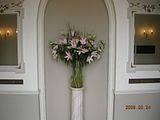


beetography
basswood-DSC_4270.jpg
White and ample flower

beetography
iris-DSC_1530.jpg
beetography
ipomoea-DSC_0906.jpg
Robert Nyman
Like, flowers
pollen-flowers posted a photo


Delicious tropical vegetables grow in Cambodia. Cambodian food is one of the world's best gourmet food. An old traditional mixture of a wide variety of vegetables, greens, salads and tasty herbal spices are used daily by most Cambodians. As a result there are many small vegetable gardens and vegetable farms. The manual method of irrigation as shown here might appear old fashions or even outdated - BUT - this method is absolutely sufficient to irrigate the vegetable fields and has the advantage of zero cost and zero overhead. No water pumps and no electricity nor fuel is needed. The vegetable harvest is rich and delicious. A healthy source of fresh cheapest and natural God made vitamins and minerals for the body.
In album Kingdom of Cambodia Pictures
A few years ago if someone had mentioned gabions I wouldn't have known what they were talking about. They were something that was used in civil engineering, large scale industrial landscaping - a million miles away from domestic gardens. Now it seems they are becoming the cool thing to have.
 At Tatton there are gabions in the show gardens, in the back to backs and on the trade stands - people are taking home DIY versions!
At Tatton there are gabions in the show gardens, in the back to backs and on the trade stands - people are taking home DIY versions!
Basically a gabion is a metal - usually steel, cage filled with stones/rocks or various heavy materials. They are usually used to retain soil in banks and terraces or as barriers. I've seen taller, slim ones used as a wall and smaller, cubed ones made into seats - the permutations are endless, as demonstrated by the two young designers of the Visionary garden, Cubed3, at this year's Tatton.
 This gold medal winning design is a modular scheme, gabions are linked together like building blocks and used in different ways - some are filled with rocks as foundations, some are filled with soil and planted and some are placed in the pond, allowing you to walk over the water's surface. Larger cages have been left empty and plants are able to grow up through them - it's very effective.
This gold medal winning design is a modular scheme, gabions are linked together like building blocks and used in different ways - some are filled with rocks as foundations, some are filled with soil and planted and some are placed in the pond, allowing you to walk over the water's surface. Larger cages have been left empty and plants are able to grow up through them - it's very effective.
On the Edible Trends garden the Reaseheath College team have filled their gabions with carefully placed layers of stones and wood in decreasing sizes, creating a very pleasing pattern and a haven for wildlife. Apparently it took them ages to do but it looks fantastic.
A very 'green' way to fill your gabions is with odd bits of bricks, slates and tiles left over from building jobs, plus any empty bottles you may have accumulated. This is what they have used on A Place for Waste, another gold medal winning garden.
As you look around the show you will see all sorts of shapes and fillings and gabions used in many ways. I am feeling quite inspired and am planning to try something with sempervivums and I rather like the idea of turf cubes.
Info from:
Private Club






No comments:
Post a Comment